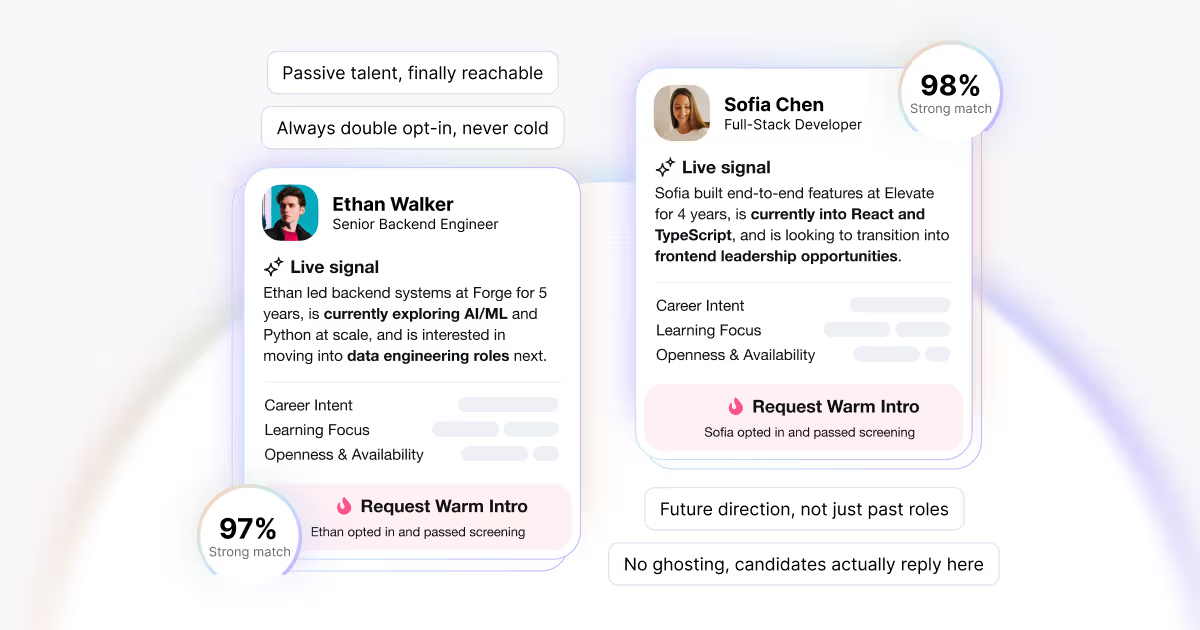


Explore essential KPIs for developer recruitment to enhance your hiring process, improve candidate quality, and reduce time-to-hire.
Developer recruitment KPIs help you measure and improve your hiring process for software engineers. These metrics focus on critical areas like time-to-hire, candidate quality, offer acceptance rates, and cost per hire, ensuring your strategies are data-driven and efficient.
Key takeaways:
- Time-to-Hire: Tracks how quickly you move candidates through the hiring process.
- Candidate Quality: Measures technical assessment pass rates and alignment with job requirements.
- Offer Acceptance Rate: Indicates how well your offers match developer expectations.
- Cost per Hire: Evaluates the total expense of filling a role.
- Source Channel Performance: Assesses the effectiveness of platforms and tools used to find candidates.
Specialized tools like daily.dev Recruiter can improve engagement by connecting you with active developers through warm introductions, leading to higher reply rates (85–90%) and better hires. Tracking these KPIs consistently helps refine your process, align with hiring goals, and attract top technical talent.
Recruiter Skill Sessions: Analytics that Matter in Talent Acquisition
Core KPIs for Developer Recruitment
Knowing which metrics to focus on can transform your developer hiring strategy into a truly data-driven process. Here are five key KPIs that serve as the foundation for measuring and refining your recruitment efforts in today’s competitive tech talent landscape. These metrics quantify each stage of developer engagement and hiring, helping you pinpoint areas for improvement.
Time to Hire and Time to Fill
Speed matters when hiring developers. Lengthy recruitment processes can cost you top-tier talent. Time to hire tracks the number of days from a candidate's first interaction to when they accept an offer, while time to fill measures the total time from job posting to filling the position. Streamlining your process - like using warm introductions with detailed context - can eliminate delays and speed things up. Monitoring these metrics can highlight bottlenecks, such as slow technical assessments or delays between interviews and offers.
Candidate Quality Metrics
Beyond speed, candidate quality ensures you're finding developers who align with both your technical needs and team dynamics. But assessing quality goes beyond scanning resumes. Consider these key metrics:
- Technical assessment pass rate: This measures the percentage of candidates who successfully complete coding challenges or technical interviews. A low pass rate might signal the need to refine your screening process, perhaps by tailoring questions to better reflect your criteria.
- Pre-vetted talent ratio: This compares candidates who meet your screening criteria upfront to those requiring further evaluation. Leveraging pre-screening platforms can improve match quality and save time for hiring teams.
"Every candidate you meet is vetted against your criteria."
- daily.dev Recruiter
Additionally, tracking hiring manager satisfaction scores for candidates who make it to final interviews can provide qualitative feedback on whether your sourcing methods align with team expectations.
Offer Acceptance Rate
Your offer acceptance rate reveals how well your opportunities align with developer preferences and market trends. A high acceptance rate usually indicates that candidates are engaged with clear, personalized opportunities and realistic expectations. Breaking this metric down by source channel can also show which methods consistently attract candidates who are more likely to accept offers.
Cost per Hire
Cost per hire takes into account all expenses related to filling a developer role, including platform fees, recruiter hours, interview costs, and agency charges. To calculate, divide your total recruitment costs by the number of hires. This metric offers a clear view of your investment when you include both direct costs (like job board fees) and indirect costs (like internal team time). Opting for predictable pricing models - such as paying per active job posting - can help you manage costs. While upfront investments may seem high, they often lead to better retention and lower long-term replacement expenses.
Source Channel Performance
Evaluating the effectiveness of your sourcing channels is crucial. Source channel performance measures how well different recruitment methods deliver qualified, engaged candidates. Track metrics like response rates, candidate quality, interview-to-offer ratios, and hire rates. For example, early data shows reply rates exceeding 85–90%. It’s also helpful to analyze the seniority of candidates from each channel - if 40% of candidates from a source are senior individual contributors or leaders, that channel may warrant greater investment.
Regularly analyzing source channel performance allows you to fine-tune your recruitment strategy, focusing resources on the channels that provide the best mix of quality, engagement, and cost-efficiency.
Tracking and Analyzing KPIs in Developer-First Recruitment
Tracking key performance indicators (KPIs) effectively turns raw data into actionable insights, helping refine your hiring process. The secret lies in setting up systems that gather accurate data and allow for meaningful analysis across various aspects of recruitment.
Best Practices for KPI Tracking
Integrate your recruitment platform with your ATS to ensure a smooth, error-free flow of candidate data. This automation reduces manual input errors and keeps your data consistent throughout the hiring process.
Adopt real-time tracking to quickly spot trends and make timely adjustments to your strategy.
Use tailored screening questions to collect data that aligns with the specific needs of your hiring managers. This approach goes beyond generic job descriptions, helping you measure candidate quality against precise criteria.
Include engagement metrics alongside traditional KPIs for a more rounded view of your recruitment performance and areas that might need tweaking.
Once your tracking systems are in place, the next step is to break down the data for sharper, more actionable insights.
Breaking Down Data for Better Insights
Digging deeper into your data can uncover patterns and trends that help fine-tune your recruitment efforts.
Segment KPI data by developer role and seniority level to identify trends that might be hidden in overall figures. Candidates at different experience levels often show varying response patterns and decision-making behaviors.
Evaluate performance by technology stack and specialization. This can highlight which groups of developers are more engaged, allowing you to adjust your strategies and set realistic goals for each technical role.
Use detailed candidate profiles, including work history, to add context to your analysis. This helps you understand what factors contribute to successful hires beyond the basics of a resume.
Compare sourcing channel performance by examining KPIs for each source. This breakdown shows not only where you’re getting the most candidates but also which channels produce the ones who advance further in the hiring process.
Displaying KPI Trends and Benchmarks
Visual dashboards can track KPI trends and compare them against benchmarks tailored to your organization. Factors like company size, location, pay scales, and technical demands should shape these benchmarks, providing a more meaningful framework for improvement.
Balance leading and lagging indicators to get a full picture of recruitment health. Metrics like offer acceptance rates tell you how well you’ve done, while engagement and interview feedback provide early signals for what’s ahead.
sbb-itb-d1e6221
Improving Developer Recruitment KPIs
Boosting your developer recruitment KPIs means rethinking how you find, evaluate, and connect with candidates. The goal is to tackle the specific challenges of hiring technical talent head-on.
Improving Screening and Sourcing
Ditch generic job descriptions and replace them with clear, detailed briefs that give candidates all the context they need upfront. This helps potential applicants determine if they’re a good fit before applying, saving time for everyone and improving the quality of candidates in your pipeline.
Create custom screening questions tailored to the role’s must-have skills. Instead of relying on resume buzzwords, these targeted questions ensure you’re evaluating candidates based on what truly matters. This can streamline your hiring process, reducing time-to-hire and increasing offer acceptance rates.
Tap into pre-qualified talent pools where developers have already proven their skills and shown interest in similar roles. This approach lightens the initial screening workload and boosts the quality of candidates entering your pipeline, leading to better hiring outcomes.
Leverage insights into developer interests to focus your outreach on the right candidates. By targeting individuals who align with your needs, you can avoid irrelevant messaging, improve engagement, and build a stronger reputation as an employer.
By refining your sourcing and screening processes, you set the stage for a smoother and more effective hiring journey.
Improving Candidate Experience
Once your sourcing strategy is fine-tuned, the next step is to ensure candidates have a positive experience throughout the recruitment process.
Stop relying on cold outreach that often leads to low response rates and damages your brand. Developers are unlikely to engage with impersonal, mass-distributed messages that don’t reflect an understanding of their skills or interests.
Offer transparent and personalized job opportunities that empower developers to make informed decisions. Sharing detailed role descriptions and company information upfront ensures candidates come to conversations prepared and genuinely interested.
Adopt a double opt-in process to confirm that candidates are actively interested in the opportunity. This method ensures that every interaction is meaningful, improving offer acceptance rates and reducing drop-offs during the hiring journey.
Remove common pain points like unclear job descriptions, lengthy applications, and poor communication. These issues can frustrate candidates, lower their satisfaction, and harm your reputation within developer circles.
Using Developer-First Platforms
When you pair improved sourcing and a great candidate experience with a developer-first platform, the results are even more impactful.
Engage developers where they already spend their time instead of pulling them away from their preferred platforms. For example, daily.dev Recruiter operates within a developer ecosystem where 1 in 50 developers worldwide are active, logging over 1 billion sessions.
Take advantage of established trust and engagement to achieve much higher response rates. While most developers ignore outreach elsewhere, on daily.dev, reply rates for double opt-in introductions consistently exceed 85–90%.
Reach passive talent that’s actively engaged, rather than relying on outdated profiles or inactive candidates. The platform connects you with developers who are current in their field, with 40% of the network made up of senior-level contributors and leaders.
Seamlessly integrate with your existing ATS and sourcing tools to keep your workflow efficient while improving candidate quality. All introduction details flow directly into your system, with automatic deduplication to avoid redundant outreach.
Measuring Success in Developer-First Recruitment
Once you've fine-tuned your recruitment process, it's crucial to evaluate the results. This helps you identify what's working, what needs tweaking, and how to keep improving. Success in developer-first recruitment hinges on setting clear goals, refining your approach, and proving the value of your efforts.
Setting Realistic KPI Benchmarks
Start by grounding your goals in industry standards, but tailor them to fit your unique situation. Think about factors like your team's hiring experience, the complexity of your tech stack, the seniority of the roles you're filling, and the current job market. Instead of relying on generic averages, use your own historical data and consider seasonal trends to set achievable milestones.
The expectations for a startup hiring its first handful of engineers are worlds apart from those of a large company expanding a 200-person tech team. Your tech stack also plays a big role - hiring React developers in San Francisco is a very different challenge than finding embedded systems engineers in a smaller city.
For example, if your current time-to-hire is 90 days, aiming to cut it down to 30 days right away is unrealistic. Instead, aim for smaller, more manageable improvements - like reducing it to 70 days in the first quarter, then 50 days by mid-year. Similarly, hiring senior engineers typically takes longer and costs more than hiring junior developers, so adjust your benchmarks accordingly.
If your offer acceptance rate has been around 60% over the past year, setting a target of 75% is both meaningful and achievable. Track these metrics across different roles and teams to identify where improvements are most needed.
Continuous Improvement Strategies
Regularly review your progress and address issues as they arise. Gather feedback from both hiring managers and candidates to identify pain points in your process. Keep an eye on both leading indicators (like application-to-phone-screen conversion rates) and lagging ones (like time-to-hire). Experiment with A/B testing to refine your job descriptions, interview formats, and outreach messages. Pay close attention to engagement metrics, such as reply rates on platforms like daily.dev Recruiter, and act quickly if you notice any declines.
Focus on metrics that genuinely reflect success, rather than vanity numbers. For instance, on daily.dev Recruiter, double opt-in introductions often result in reply rates of 85–90% or higher, showing strong candidate interest.
Leverage real-time tracking tools to catch trends before they become bigger problems. These proactive strategies not only improve your metrics but also set the foundation for long-term success.
Showing KPI Improvement Results
To highlight the impact of your efforts, compare your baseline metrics to the results after implementing changes. Tailor your presentation to your audience - engineering leaders might care most about candidate quality, while finance teams are likely focused on cost-per-hire. Share both the numbers (like reduced time-to-hire) and qualitative improvements (such as better feedback from hiring managers). Show how small changes can snowball into bigger wins, like faster sourcing leading to overall improved metrics.
Document the specific changes that led to better results. For example, if adopting double opt-in introductions consistently boosted reply rates, this can serve as a playbook for future recruitment strategies.
Use visuals like charts and graphs to make your data easy to digest. A month-over-month improvement chart or a comparison of sourcing channels can tell a clearer story than a dense spreadsheet.
Finally, translate your KPI improvements into tangible business outcomes. For example, if cutting time-to-hire by 15 days across 20 hires saved $50,000 in productivity costs, lead with that figure. Connecting metrics to real-world results helps demonstrate the broader value of your recruitment efforts.
Conclusion: Success with Developer Recruitment KPIs
Fine-tuning your recruitment KPIs is the key to building a hiring process that’s both effective and efficient. The metrics highlighted in this guide act as your roadmap, helping you navigate the competitive world of developer recruitment while making smarter, data-backed decisions. By focusing on these key indicators and applying the strategies discussed, you can improve both your hiring efficiency and the overall candidate experience.
The secret to managing KPIs effectively is selecting the metrics that align with your unique needs. Prioritize core indicators like time-to-hire, candidate quality scores, offer acceptance rates, and cost-per-hire, but always keep context in mind. Benchmarks can differ depending on your team size and where you are in your hiring journey.
Tracking and analyzing these metrics consistently turns raw data into actionable insights. Even small adjustments - like refining job descriptions, improving interview workflows, or experimenting with new sourcing methods - can lead to meaningful, long-term improvements when measured against your KPIs.
Tools like daily.dev Recruiter can amplify your results. By focusing on warm, double opt-in introductions, this platform eliminates the inefficiency of cold outreach and connects you with passive candidates who are genuinely open to new opportunities. It’s a trust-driven approach that complements the metrics discussed, keeping your process streamlined and candidate-focused.
The best KPIs strike a balance between efficiency and candidate satisfaction, ultimately strengthening your employer brand. When you improve metrics like time-to-hire and offer acceptance rates while enhancing the candidate experience, you create a hiring process that doesn’t just fill roles - it builds lasting connections within the developer community.
As your team evolves and market conditions shift, it’s essential to revisit and refine your KPIs. By staying focused on metrics like time-to-hire, candidate quality, and cost-per-hire, you ensure every step of your recruitment process delivers measurable results. Keep experimenting, stay flexible, and let your data guide you toward better decisions that benefit both your organization and the talented developers you’re looking to bring on board.
FAQs
How does tracking KPIs help improve the quality of developer hires?
Tracking key performance indicators (KPIs) in developer recruitment allows you to make smarter, data-backed decisions during the hiring process. Metrics like time-to-hire, source effectiveness, and candidate engagement provide valuable insights into what’s working and what needs adjustment.
For instance, KPIs might highlight that your job descriptions aren’t resonating with the right candidates, your sourcing channels could use tweaking, or your candidate experience might need some attention. By addressing these areas, you can attract and secure developers who not only meet the technical requirements but also align well with your team, leading to stronger, more impactful hires.
How can I reduce the time it takes to hire developers?
Reducing the time it takes to hire developers calls for a mix of trust, efficient processes, and clear communication. Start by establishing credibility within the developer community - this helps boost response rates and keeps candidates engaged. Focus your efforts on warm, pre-qualified candidates who are already open to exploring new opportunities to streamline the process.
Make sure candidates have a seamless experience by sharing all the key details about the role upfront. This transparency allows them to make quicker, more informed decisions. Collaborate closely with hiring managers to ensure everyone is on the same page and avoid mismatched expectations that could slow things down. Lastly, use targeted screening methods to match candidates to the role’s exact requirements, saving time for both the team and the candidates.
How can using tools like daily.dev Recruiter improve recruitment KPIs?
Using tools like daily.dev Recruiter can transform recruitment efforts by connecting employers with pre-qualified developers in a space where they’re already engaged. This approach shifts the focus from impersonal cold outreach to warm, double opt-in introductions, ensuring that candidates are genuinely interested in the roles offered.
By prioritizing quality over sheer volume, daily.dev Recruiter simplifies the hiring process, improves candidate matching, and boosts reply rates. These improvements lead to more effective hiring decisions and smarter use of resources, resulting in stronger recruitment performance across the board.






